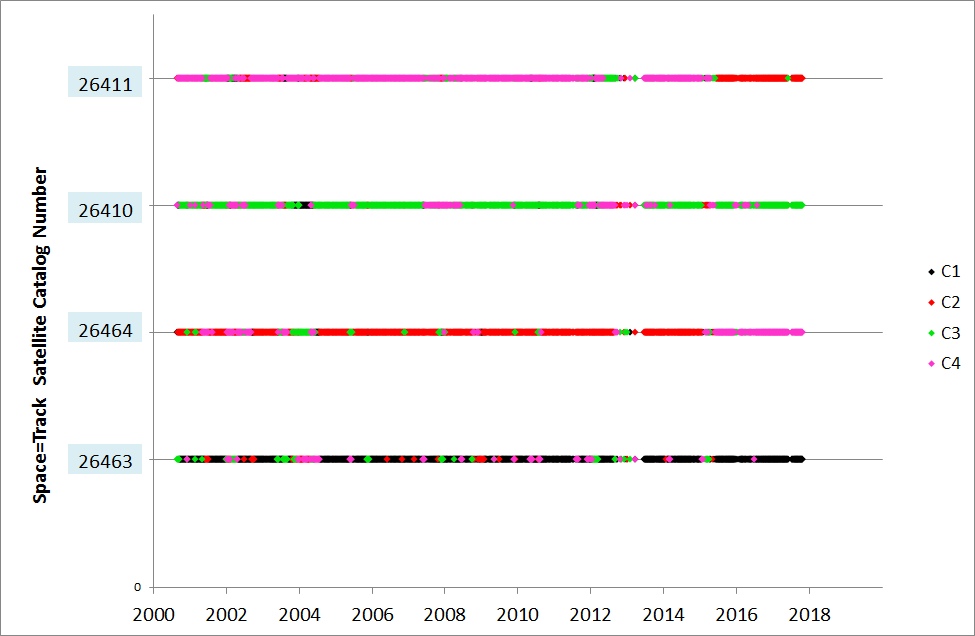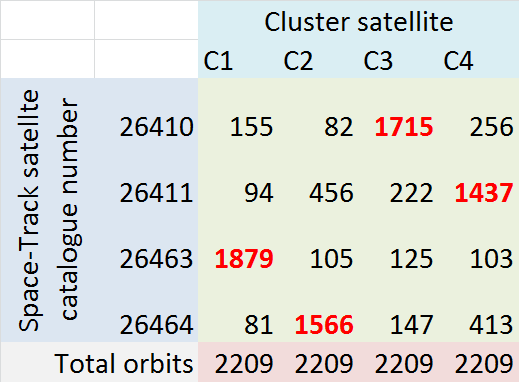Cluster Spacecraft Identifiers
This page provides a cross-reference table for the various identifiers used to describe the four
Cluster spacecraft. Note that it replaces an earlier analysis published in 2008; for the completeness of the record, that old version is available here. Please send any requests for further changes to
Mike Hapgood.
The table also includes the guidelines agreed by the Cluster Science Working
Team for plotting data from the four Cluster spacecraft.
The use of these guidelines is not mandatory. But it will make data analysis
and comparison much easier if everyone uses the same convention.
| ESA Name | | Rumba | Salsa | Samba | Tango |
| Launch date | | 9 Aug 2000 | 16 Jul 2000 | 16 Jul 2000 | 9 Aug 2000 |
| ESA Number | | 1 | 2 | 3 | 4 |
| COSPAR ID | | 2000-045A | 2000-041B | 2000-041A | 2000-045B |
| Primary Space-Track satellite catalogue number* | | 26463 | 26464 | 26410 | 26411 |
| CSDS Code | | C1 | C2 | C3 | C4 |
| ESOC FD code | | S1 | S2 | S3 | S4 |
| ESA Flight Model number | | FM5 | FM6 | FM7 | FM8 |
| | | | | | |
| Plotting guidelines |
| | | | |
| Colour | | Black | Red | Green | Magenta |
| Line Style | | Solid | Dashed | Dotted | Dash-dot-dot-dot |
| Symbols | | Cross | Plus | Asterisk | Star |
| or | | Square | Diamond | Circle | Triangle |
*IMPORTANT:
Analysis of the two-line-elements from Space-Track suggests that the satellite catalogue numbers in those elements do not have a fixed mapping to specific Cluster spacecraft, e.g. catalogue number 26463 is mainly mapped to Cluster 1, but some occasions is mapped one or the other of Cluster 2, 3 and 4. See below for a detailed analysis of this issue.
Notes
ESA Number. This is the spacecraft id used in Cluster operations by ESOC and JSOC.
COSPAR ID (also known as the International Designation). This id is assigned by World Data Center A for Rockets
and Satellites at NASA Goddard Space Flight Center following spacecraft launch. It is the unique designator that is
required for all spacecraft under international law. It takes the form YYYY-LLLI, where YYYY is the year of launch,
LLL is the launch number and I is a letter that distinguish the different items launched.
Space-Track catalogue number (also formerly known as the NORAD catalogue number). This is the catalogue number assigned by
the US Joint Space Operations Center when an object is first tracked.
CSDS code. This is the two-character spacecraft code used in the data products
produced by the Cluster Science Data System (CSDS).
ESOC FD Code. This is the two-character spacecraft code used in the names of
orbit and event files produced by ESOC Flight Dynamics.
ESA Flight Model number. These are the numbers used by ESA during the construction and ground testing of the Cluster-II spacecraft. Note that this sequence follows on from that used for the construction and ground testing of the original
Cluster-I spacecraft.
Symbols. The first set of symbols are made out of line segments, whereas
the second set may be either outlines or solid-filled.
Note that asterisks have 6 legs and stars have 5 points.
Other spacecraft linked to Cluster
Space-Track
catalogue number |
COSPAR ID |
Description |
| 26106 | 2000-015A |
This object is shown as FREGAT RB/CLUSTER 2 in the USSPACECOM
catalogue. It is thought to be one of the test versions of the Fregat upper stage that was flown
before the main Cluster launches. It remains in orbit in 2008 as its perigee is around 400km. |
| 26412 | 2000-041C |
This is the Fregat upper stage from the first Cluster launch. It
was intentionally de-orbited and decayed within a few hours of the launch. |
| 26465 | 2000-045C |
This is the Fregat upper stage from the second Cluster launch. It
was intentionally de-orbited and decayed within a few hours of the launch. |
Comparision of TLE data with definitive data from ESOC
To match the Space-Track catalogue numbers with the four Cluster spacecraft, we have compared perigee times from
the Space-Track two-line elements (TLE) with with the definitive times in the Cluster event files provided by ESOC. We take the TLE perigee time as Tp = Te - k*MA/R, where Te is the epoch time,
MA is the mean anomaly at the epoch, R the revolution rate and k is the constant to match units of the
different elements; k= 1/360 if MA is in degrees, Tp and Te in days and R is in revolutions per day.
Note that MA must be adjusted to be in the range -180 to +180 degrees in order to derive the perigee time nearest to the epoch time.
The present analysis covers the period from 5 September 2000 to 31 October 2017 (orbits 31 to 2727), thus excluding the early phase of July and August 2000 when the satellite sometimes had very different orbits. We looked for orbits where Space-Track provides four distinct sets of two-line elements and hence four distinct perigee times, one for each of the Space-Track catalogue numbers. For each of these orbits we then matched the time order of the TLE-derived perigees with the time order provided by ESOC perigee times. This matching then allowed us to associate each catalogue number (24610, 24611, 24463 and 24464) with a particular Cluster spacecraft (i.e. as identified in the perigee times provided by ESOC). We found a total of 2209 orbits (out of 2696) in which we had four distinct TLE-derived perigee times and hence 2209 separate associations between the SpaceTrack catalogue numbers and the definitive Cluster ids provide by ESOC. The timeline of these associations is shown in the figure below. Each of the four horizontal lines indicates one of the Space-Track catalogue numbers, whilst the colours indicate which of the four Cluster spacecraft is associated with that catalogue number at any particular time. The colours follow the standard scheme as noted in the table above.

These results are summarised in the table below which shows the numbers of matches from each Space-Track catalogue numbers to each of the Cluster spacecraft. The primary matches are highlighted in red, but it is clear that other matches are common. A striking feature is that, from June 2015 onwards, the primary match of C2 and C4 appears to have swapped. This swap is a better fit to mission history; C2 was one of the first pair of Clusters to be launched (along with C3) so should have a lower catalogue number than C4.

This analysis allows us to compare, for each spacecraft, 2209 TLE-derived perigee times with those provided by ESOC. The time series of differences in the perigee times is shown in the four figures; negative differences indicate TLE perigee times before ESOC perigee times. To provide good resolution in time differences, we focus on differences of plus or minus 60 minutes and ignore the small number of large outliers. This highlights a distinct oscillatory feature that starts in the summer of 2006 - this is not yet understood.
The differences in TLE versus ESOC perigee times shown in these plots are much less than those shown in the 2008 analysis. This provides strong evidence in support of the approach above in which we match a time series of different Space-Track catalogue numbers to each Cluster. This matching provides much greater consistency between the Space-Track and ESOC datasets.
Last updated by Mike
Hapgood ( mike.hapgood@stfc.ac.uk),
27 November 2017
|